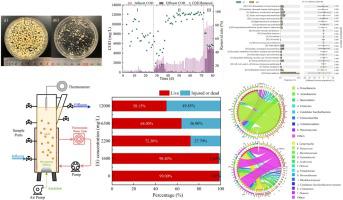当前位置:
X-MOL 学术
›
Biochem. Eng. J.
›
论文详情
Our official English website, www.x-mol.net, welcomes your
feedback! (Note: you will need to create a separate account there.)
Biodegradation of real industrial wastewater containing ethylene glycol by using aerobic granular sludge in a continuous-flow reactor: Performance and resistance mechanism
Biochemical Engineering Journal ( IF 3.7 ) Pub Date : 2020-09-01 , DOI: 10.1016/j.bej.2020.107711 Kang Qi , Zhengwen Li , Chen Zhang , Xuejun Tan , Chunli Wan , Xiang Liu , Li Wang , Duu-Jong Lee
Biochemical Engineering Journal ( IF 3.7 ) Pub Date : 2020-09-01 , DOI: 10.1016/j.bej.2020.107711 Kang Qi , Zhengwen Li , Chen Zhang , Xuejun Tan , Chunli Wan , Xiang Liu , Li Wang , Duu-Jong Lee

|
Abstract The application of aerobic granular sludge in continuous-flow treatment of real organic industrial wastewater has been a current research hotspot. This research explored the feasibility of real ethylene glycol wastewater treatment by aerobic granular sludge in a continuous-flow process. In this study, an 80-day continuous-flow reactor operation was established to investigate the toxic effects of ethylene glycol industrial wastewater on aerobic granular sludge and the resistance mechanism of aerobic granules during long-term operation. Results revealed that after 40 days of domestication, the degradation rate of COD for 2000 ± 150 mg/L remained above 85 % and EG concentration was below the detection limit. Flow cytometry results showed that the toxicity of ethylene glycol to cells was mainly reflected in the destruction of cell membranes, leading to the decline of the microbial activity. Long-term exposure to ethylene glycol industrial wastewater would reduce the mechanic strength of aerobic granules. Through metagenomic sequencing technology, it was confirmed that the ability to metabolize organic matter and the defense function were improved by microorganisms in aerobic granules during the process, however, the productivity of cells was reduced, and both the intracellular repair and cytoskeleton synthesis of AGS were inhibited. Based on the KEGG database, a metabolic network of ethylene glycol from granular sludge microorganisms was reconstructed.
中文翻译:

好氧颗粒污泥在连续流反应器中生物降解含乙二醇的实际工业废水:性能和阻力机制
摘要 好氧颗粒污泥在实际有机工业废水连续流处理中的应用一直是当前的研究热点。本研究探讨了好氧颗粒污泥在连续流动过程中真正处理乙二醇废水的可行性。本研究建立了80天连续流反应器运行,研究乙二醇工业废水对好氧颗粒污泥的毒性作用及长期运行过程中好氧颗粒的阻力机理。结果表明,驯化40天后,2000±150mg/L的COD降解率保持在85%以上,EG浓度低于检测限。流式细胞仪结果显示乙二醇对细胞的毒性主要体现在细胞膜的破坏上,导致微生物活性下降。长期接触乙二醇工业废水会降低好氧颗粒的机械强度。通过宏基因组测序技术证实,在此过程中,好氧颗粒中的微生物提高了对有机物的代谢能力和防御功能,但细胞生产力降低,AGS的细胞内修复和细胞骨架合成均受到影响。抑制。基于KEGG数据库,重建了颗粒污泥微生物乙二醇代谢网络。证实在此过程中好氧颗粒中的微生物提高了对有机物的代谢能力和防御功能,但细胞生产力降低,AGS的细胞内修复和细胞骨架合成均受到抑制。基于KEGG数据库,重建了颗粒污泥微生物乙二醇代谢网络。证实在此过程中好氧颗粒中的微生物提高了对有机物的代谢能力和防御功能,但细胞生产力降低,AGS的细胞内修复和细胞骨架合成均受到抑制。基于KEGG数据库,重建了颗粒污泥微生物乙二醇代谢网络。
更新日期:2020-09-01
中文翻译:

好氧颗粒污泥在连续流反应器中生物降解含乙二醇的实际工业废水:性能和阻力机制
摘要 好氧颗粒污泥在实际有机工业废水连续流处理中的应用一直是当前的研究热点。本研究探讨了好氧颗粒污泥在连续流动过程中真正处理乙二醇废水的可行性。本研究建立了80天连续流反应器运行,研究乙二醇工业废水对好氧颗粒污泥的毒性作用及长期运行过程中好氧颗粒的阻力机理。结果表明,驯化40天后,2000±150mg/L的COD降解率保持在85%以上,EG浓度低于检测限。流式细胞仪结果显示乙二醇对细胞的毒性主要体现在细胞膜的破坏上,导致微生物活性下降。长期接触乙二醇工业废水会降低好氧颗粒的机械强度。通过宏基因组测序技术证实,在此过程中,好氧颗粒中的微生物提高了对有机物的代谢能力和防御功能,但细胞生产力降低,AGS的细胞内修复和细胞骨架合成均受到影响。抑制。基于KEGG数据库,重建了颗粒污泥微生物乙二醇代谢网络。证实在此过程中好氧颗粒中的微生物提高了对有机物的代谢能力和防御功能,但细胞生产力降低,AGS的细胞内修复和细胞骨架合成均受到抑制。基于KEGG数据库,重建了颗粒污泥微生物乙二醇代谢网络。证实在此过程中好氧颗粒中的微生物提高了对有机物的代谢能力和防御功能,但细胞生产力降低,AGS的细胞内修复和细胞骨架合成均受到抑制。基于KEGG数据库,重建了颗粒污泥微生物乙二醇代谢网络。











































 京公网安备 11010802027423号
京公网安备 11010802027423号